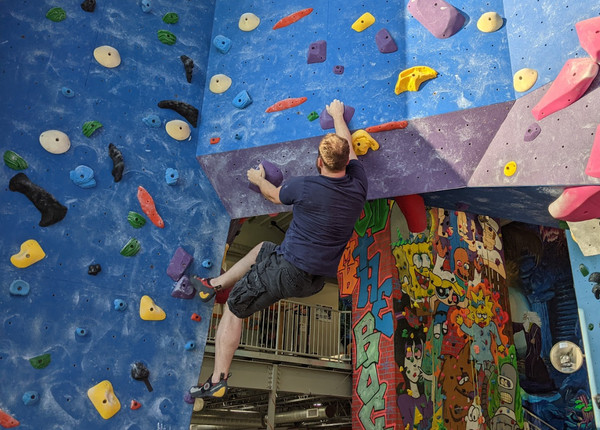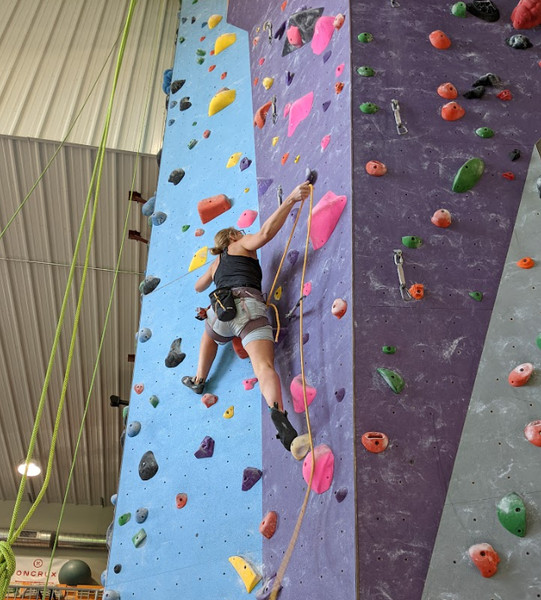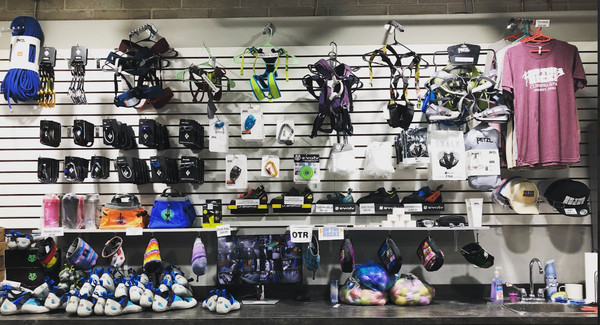How To Begin Rock Climbing? Rock climbing is an exhilarating activity that challenges your physical and mental strength, allowing you to connect with nature or push your limits in a controlled environment. At rockscapes.net, we provide you with a comprehensive guide, simplifying the process into manageable steps, ensuring you can confidently start your rock climbing journey, whether it is indoor or outdoor. Discover the thrill of scaling walls and unlocking new heights with our expert guidance on the essential rock climbing techniques and equipment, plus all about rock landscape, and outdoor rock placement.
1. Discovering Rock Climbing Forms: Top Rope and Bouldering
Understanding the various climbing forms is crucial when learning how to begin rock climbing. Each form requires specific rock climbing gear and training, so let’s explore some of the most accessible forms for beginners: top rope climbing and bouldering.
1.1. Top Rope Climbing: Scaling New Heights with Safety
Top rope climbing is an excellent starting point, allowing you to ascend higher with the security of a rope system. This technique involves tying one end of the rope to the climber, which then runs through an anchor at the top of the climb. A partner, known as the “belayer,” manages the rope’s slack as the climber ascends.
 Top rope climbing for beginners
Top rope climbing for beginners
The belayer keeps the rope tight, so if the climber slips, the fall is minimized. According to the American Alpine Club, learning to belay is a fundamental skill taught in most beginner rock climbing courses.
1.2. Bouldering: The Accessible Entry Point
Bouldering requires minimal rock climbing gear and is an excellent way to start learning how to begin rock climbing. Bouldering involves climbing shorter routes, often close to the ground, without ropes or harnesses.
 Indoor bouldering for beginner rock climbers
Indoor bouldering for beginner rock climbers
This form allows beginners to focus on technique and build strength without the added complexity of rope systems. Bouldering is an excellent starting point if you are learning how to begin rock climbing because it offers a focused and straightforward introduction to the sport’s fundamental movements.
2. Starting with a Test Climb: Indoor vs. Outdoor
When learning how to begin rock climbing, the next step is to try it out! You can participate in top rope climbing and bouldering both indoors and outdoors. Indoor climbing gyms provide a controlled environment, making them ideal for beginners.
2.1. Indoor Rock Climbing: A Controlled Environment for Beginners
Indoor climbing gyms, like those near Arizona State University, offer several advantages for those learning how to begin rock climbing. They provide a safe, predictable environment with floor mats for safer landings, color-coded routes to indicate difficulty levels, and pre-set top ropes.
2.2. Outdoor Rock Climbing: A Realistic Experience
Outdoor rock climbing provides a more authentic experience but requires more advanced knowledge and preparation.
 Outdoor Rock climbing requires more advanced preparation
Outdoor Rock climbing requires more advanced preparation
A trained professional must set up top ropes, and climbers need to be aware of weather conditions and potential hazards.
3. Mastering the Basics: Essential Skills and Techniques
To begin rock climbing safely, you must learn the fundamentals from a qualified trainer. A typical top rope course covers essential skills such as understanding rock climbing gear, belaying techniques, and knot tying.
3.1. Essential Skills for Top Rope Climbing
Here are some fundamental skills you’ll learn during a rock climbing class:
- Knot Tying: Mastering the figure 8 knot-tying technique is crucial for securing the rope.
- System Checks: Before each climb, inspect the knot, belay equipment, helmet, and harness.
- Belaying: Learn how to properly set up and use your belay equipment to ensure the climber’s safety.
- Fundamentals of Movement: Understand basic footwork and body positioning to climb efficiently.
3.2. Essential Rock Climbing Gear for Beginners
When you’re learning how to climb, having the right gear is essential. Most indoor gyms provide rock climbing gear for beginners. You’ll want to invest in your own gear as you progress, ensuring it’s well-maintained and inspected regularly.
 Necessary Rock Climbing Gear to get started
Necessary Rock Climbing Gear to get started
Essential rock climbing tools and gear include:
| Gear | Description |
|---|---|
| Clothing | Comfortable, breathable clothing that allows free movement and dries quickly. |
| Rock Climbing Shoes | Snug-fitting shoes with good grip. |
| Chalk | Improves grip by absorbing sweat. |
| Harness | Securely ties the rope to the climber. |
| Helmet | Protects the head from falling debris. |
| Belay Equipment | Allows the belayer to control the rope. |
| Rope | Essential for top rope climbing; typically provided at gyms. |
| Locking Carabiner | Used with belay equipment for secure connections. |
4. Honing Your Skills: Practice and Certification
Practicing your climbing skills is vital when learning how to begin rock climbing. After completing your rock climbing classes, take a top rope test to assess your skills.
4.1. The Importance of Certification
Obtaining certification allows you to climb independently at indoor gyms. This certification demonstrates that you understand and can apply the fundamental safety techniques.
4.2. Climbing Gyms: A Social and Skill-Building Environment
As you gain experience, you’ll recognize the difficulty levels of different climbs. Indoor climbing gyms offer a variety of routes for beginner and advanced climbers. According to a study by the American Mountain Guides Association, climbing gyms provide a supportive environment for climbers to improve their skills and connect with other enthusiasts.
5. Advancing Your Climbing Journey
As you grasp the basics of rock climbing, numerous opportunities arise to advance your skills. Many climbers challenge themselves with bouldering, while others prefer more technical climbs.
5.1. From Top Rope to Lead Climbing
Once you’re comfortable with top rope climbing, you might be ready for lead climbing. Lead climbing involves clipping your rope to protection points as you ascend, increasing the challenge and requiring more advanced skills.
5.2. Exploring Outdoor Environments
Many rock climbers are drawn to the sport because of the opportunity to explore outdoor environments. After mastering the basics, learn how to set up a top rope anchor to climb safely in natural settings. Rock climbing offers endless opportunities for adventure, whether you’re a beginner or an advanced climber.
6. Rockscapes.net: Your Partner in Creating Stunning Rock Landscapes
At rockscapes.net, we understand the allure of natural stone and its ability to transform outdoor spaces. Whether you’re a homeowner, landscape designer, or contractor, we offer a wide range of natural stones to enhance your projects.
6.1. Enhancing Landscapes with Natural Stone
Natural stone can add beauty, durability, and a touch of elegance to any landscape. From granite to slate, we source the finest materials to meet your design needs.
6.2. Serving Arizona’s Unique Landscape Needs
Located in Tempe, Arizona, rockscapes.net is dedicated to serving the local community with high-quality materials and expert advice. Our team understands the unique challenges and opportunities presented by the Arizona landscape and can help you select the perfect stones for your project.
6.3. Meeting the Needs of Diverse Clientele
We cater to a diverse range of clients, including:
- Homeowners seeking to enhance their yards.
- Landscape designers and architects looking for unique natural stones.
- Gardeners and plant enthusiasts wanting to create focal points.
- DIY enthusiasts working on outdoor projects.
- Suppliers and businesses in the construction and decoration industry.
6.4. Addressing Key Customer Challenges
We address the challenges our customers face by providing:
- Detailed information on different types of natural stones.
- Design ideas and project examples.
- Step-by-step guides for simple landscape projects.
- A list of trusted stone suppliers near you.
- Advice on maintaining and caring for natural stone installations.
6.5. Providing Essential Services
Our services are designed to help you:
- Discover a variety of design inspirations.
- Learn about different types of stones.
- Receive expert advice from our team.
7. The Allure of Rock Climbing: More Than Just a Sport
Rock climbing offers more than just a physical challenge. It’s a way to connect with nature, build confidence, and become part of a supportive community. Whether you’re scaling indoor walls or exploring outdoor crags, the world of rock climbing is waiting to be discovered.
7.1. Building Confidence and Mental Strength
Rock climbing requires problem-solving skills, mental focus, and perseverance. Each climb presents a new puzzle to solve, helping climbers develop mental resilience and self-confidence.
7.2. Joining a Supportive Community
The rock climbing community is known for its inclusivity and support. Whether you’re a beginner or an experienced climber, you’ll find encouragement and camaraderie at climbing gyms and outdoor climbing areas.
7.3. Connecting with Nature
Outdoor rock climbing provides a unique opportunity to connect with nature and appreciate the beauty of natural landscapes. Climbing in remote areas allows you to escape the hustle and bustle of everyday life and immerse yourself in the serenity of the natural world.
8. Integrating Rock Climbing with Landscape Design
Rock climbing and landscape design may seem like unrelated fields, but they share a common appreciation for natural stone and outdoor spaces. Incorporating rock climbing elements into your landscape design can create a unique and dynamic environment.
8.1. Creating Climbing Walls in Your Backyard
For those with a passion for rock climbing, consider incorporating a climbing wall into your backyard design. A professionally designed climbing wall can provide a fun and challenging activity for the whole family while adding a unique architectural element to your outdoor space.
8.2. Using Boulders as Landscape Features
Boulders can be used to create natural-looking focal points in your landscape. They can be strategically placed to add visual interest, create seating areas, or define pathways. According to landscape architects, using natural stone in landscape design enhances the aesthetic appeal and increases the property’s value.
8.3. Combining Climbing and Gardening
Combining climbing structures with vertical gardens can create a stunning and functional landscape design. Climbing plants can be trained to grow on climbing walls, adding greenery and visual interest to the structure.
9. Rock Climbing in the USA: Hotspots and Resources
The United States offers some of the best rock climbing destinations in the world, from the granite cliffs of Yosemite to the sandstone towers of Moab. Whether you’re a beginner or an experienced climber, you’ll find a wealth of resources and opportunities to explore the sport.
9.1. Popular Rock Climbing Destinations
Some of the most popular rock climbing destinations in the USA include:
- Yosemite National Park, California: Known for its iconic granite cliffs and challenging climbs.
- Red Rock Canyon, Nevada: Offers a variety of climbing routes on sandstone formations.
- Moab, Utah: Features stunning desert landscapes and world-class climbing.
- New River Gorge, West Virginia: A popular destination for sport climbing and traditional climbing.
- Arizona, with mountains and hot weather offer great rock climbing spots.
9.2. Finding Climbing Gyms Near You
If you’re looking for a local climbing gym, use online resources like the Climbing Business Journal or Google Maps to find gyms near you. Many gyms offer introductory courses and equipment rentals for beginners.
9.3. Joining Climbing Communities
Joining a climbing community is an excellent way to meet other climbers, learn new skills, and stay informed about local climbing events. Online forums, social media groups, and local climbing organizations can connect you with a supportive community of climbers.
10. Expert Advice on Choosing the Right Climbing Stone
When incorporating stone into your landscape, selecting the right type is crucial. Different stones offer varying aesthetics, durability, and suitability for different applications.
10.1. Considering Aesthetics
The aesthetic appeal of the stone should complement your overall landscape design. Consider the color, texture, and shape of the stone when making your selection.
10.2. Assessing Durability
Durability is an essential factor, especially in harsh climates. Granite and basalt are known for their exceptional durability and resistance to weathering.
10.3. Evaluating Porosity
The porosity of the stone affects its ability to absorb water, which can lead to cracking in freezing temperatures. Non-porous stones like slate and quartzite are ideal for wet environments.
10.4. Understanding Stone Availability
Stone availability can vary depending on your location. Local quarries often offer a range of stones that are well-suited to the local climate and environment.
11. Maintaining Your Rock Landscape for Longevity
Proper maintenance is essential to keep your rock landscape looking its best for years to come. Regular cleaning, weed control, and occasional repairs can help preserve the beauty and integrity of your stone features.
11.1. Regular Cleaning
Regular cleaning can remove dirt, moss, and algae from your stone features. Use a mild detergent and a soft brush to clean the stone gently, avoiding harsh chemicals that could damage the surface.
11.2. Weed Control
Weeds can detract from the beauty of your rock landscape and can even damage the stone over time. Use a weed barrier fabric beneath your stone features to prevent weed growth, and regularly remove any weeds that do appear.
11.3. Repairing Cracks and Damage
Cracks and damage to your stone features should be repaired promptly to prevent further deterioration. Use a stone sealant or epoxy to fill cracks and stabilize damaged areas.
12. Frequently Asked Questions About Rock Climbing
12.1. How Do You Start Rock Climbing for Beginners?
Taking a beginner course at a local gym is the best way to start rock climbing.
12.2. Can You Teach Yourself to Rock Climb?
You can teach yourself to rock climb with enough dedication at a top rope or bouldering gym.
12.3. Do I Need to Be Fit to Start Rock Climbing?
Rock climbing requires a basic level of strength and fitness.
12.4. Can I Go Bouldering with No Experience?
Bouldering is easy to learn, so you can start immediately, even as a beginner.
12.5. What Skills Do You Need for Climbing?
Climbing requires skills such as belaying, rappelling, and setting anchors.
12.6. What is the Best Time of Year to Start Rock Climbing?
The best time to start rock climbing depends on your location and climate. In general, spring and fall offer moderate temperatures and comfortable climbing conditions.
12.7. What are the Benefits of Rock Climbing?
Rock climbing offers numerous physical and mental benefits, including increased strength, endurance, flexibility, and problem-solving skills.
12.8. How Do I Choose the Right Climbing Gym?
When choosing a climbing gym, consider factors such as location, equipment, route variety, and staff expertise.
12.9. What Should I Wear to My First Rock Climbing Class?
Wear comfortable, athletic clothing that allows free movement. Avoid loose clothing that could get caught in the climbing equipment.
12.10. How Can I Find a Rock Climbing Partner?
Join a local climbing club or online forum to connect with other climbers. Climbing gyms often have bulletin boards where climbers can post looking for partners.
Rock climbing is more than just a sport; it’s a lifestyle. With the right training, equipment, and mindset, you can enjoy the thrill of scaling new heights and becoming part of a vibrant community.
Ready to explore the world of rockscapes? Visit rockscapes.net to discover design ideas, learn about different types of stones, and receive expert advice. Contact us at 1151 S Forest Ave, Tempe, AZ 85281, United States, or call +1 (480) 965-9011. Let us help you create stunning rock landscapes that will last a lifetime!
